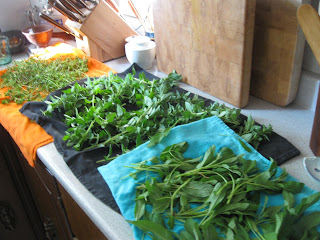Out in the garden this morning, I noticed that the thyme had started to flower (it's about thyme, I said!). (groan). This is the signal to do a haircut on the herbs, and do the season's first batch of drying. (It's a pain if the flowering gets too far along, since you get a bunch of crap in your dried herbs -- i.e. flowers and seeds -- so it's best to head this off at the pass!)
I started with the oregano. It was chugging along nicely, and ...
... looked like this after the trim. Basically, I just head out with scissors and a big bowl, and snip away. Mow them down low enough that you get a good section of stalk, but not so low that there's nothing left to keep growing.
Here's the thyme before...
... and after.
I also trimmed the sage. (See the flowers starting?) I don't use a whole lot of sage over the winter, but it is nice to have on hand. (I steered clear of the lovage -- too scary!)
These herbs will far surpass anything you can buy at the store. I recall reading some FDA guidelines for herbs specifying the amout of dirt and the number of insect parts and rodent hairs that are acceptable in commercial preparations. I aim for pretty much zero of both.
The first step is to give the trimmed herbs a wash. If you're strategic in your trimming, you'll avoid the dirty parts of the plant and only trim the clean stuff (chuck the parts with spit-bugs on them too). Then all you need are a couple of rinses in cool water (I use a big bowl to do the rinsing). Rinse in small batches so it isn't too crowded and you get good water circulation. Once that's done, shake them out to remove excess water, and plunk them down on tea towels to start drying.
Here's the yield so far. Don't be deceived, however -- all this will dry down to about a teaspoon. I go through a lot of oregano and thyme through the winter, so I'll be repeating this shearing exercise every month or so. My stocks are down to the wire now, so this harvest comes just in time. (Save some fresh oregano to make some chimichurri if you're keen on doing some Argentinian grilling this weekend!)
Now, how to dry it. This is the key part of the process. If you dry the herbs too slowly and in high humidity, the leaves will start to darken. Basically, you'll be making black tea out of your herbs and creating a whole new taste sensation that may or may not be any good. The key to success (and green dried herbs) is a fast dry in a low humidity environment. This leads me to the brainwave of the century: I dry my herbs at work in my super dry and hot office.
I am even famous for it! This is from the August/September 2002 issue of Fine Cooking. My first published work. (Although I must confess, the text looks almost nothing like what I sent -- the original was WAY more hilarious.) ANYWAY, the point of all this is that the inhuman dryness and generally unpleaseant conditions in the average 1970s era office building are perfect for drying herbs. Pop them on your desk on Friday (like I'm going to do tomorrow) and they'll probably be ready Monday morning! The only challenge is in meeting all the "Is that pot?" comments with a clever answer.
Bon appetit! Remember, it's time to get ready for winter. The days start getting shorter in less than a month!
Subscribe to:
Post Comments (Atom)








You have seen my 1998 orange and the apple from 2000, right?
ReplyDelete